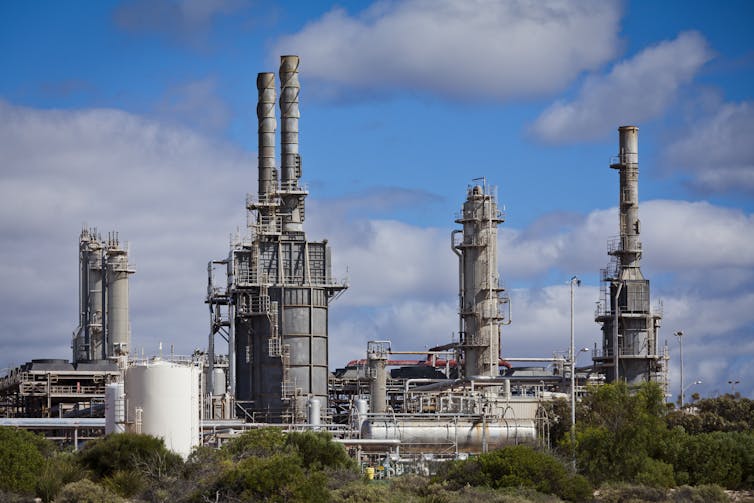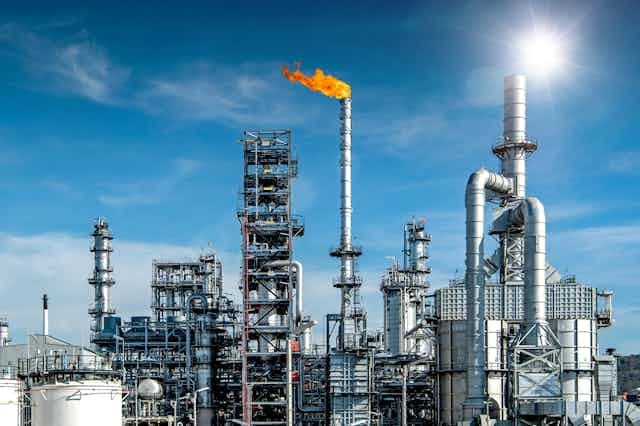Rapid reductions in fossil fuel production and use are essential to limit global warming to 1.5°C compared to pre-industrial levels. Our new research shows most of the world’s major coal, oil and gas companies are yet to make meaningful reductions.
Some companies have been quick to announce net-zero targets or other claims of alignment with the Paris Agreement. But how do their actions compare to what must be done to achieve the agreed goal of keeping the temperature increase below 1.5°C?
Our research developed a method to track whether production by individual fossil fuel companies is aligned with putting the world on a 1.5°C climate pathway. We use production budgets as these can be compared directly with fossil fuel demand scenarios and avoid the need for complex emissions calculations.
More than 60% of the top 142 oil, gas and coal companies – including three of the five Australian companies assessed – were not on track. Rio Tinto and BHP were the two Australian companies found to be on track. Between 2014 and 2020, the fossil fuel sectors exceeded overall production budgets by 64% (oil), 63% (gas) and 70% (coal).
These budgets are the levels of production needed to limit warming to 1.5°C under the Paris Agreement “middle-of-the-road scenario” (where trends broadly follow their historical patterns).
We need freely available information to understand the impact companies are having on the climate and to hold them accountable. Our results are on the website Are you Paris compliant?.

How can we track companies’ actions?
In an earlier research paper, we laid the foundation of what Paris compliance means using a strict science-based approach. We developed several conditions.
Firstly, the base year of measuring progress of an entity should be the same as the starting year of the decarbonisation scenario being used. While there are many such scenarios, the pathway has to be consistent with a 1.5°C or “well below” 2°C warming limit as stated in the Paris Agreement.
To prevent constant delay of action, only pathways starting in or before 2015 should be used. That’s when the world’s nations committed to decarbonisation under the Paris Agreement. For example, if a company wants to track its alignment with a well-below 2°C pathway starting in 2014, it should start tracking from 2014.
Also, companies should make up for action deficits since the base year to stay within their budgets.
Commonly used frameworks such as the Science Based Targets initiative (SBTi) and the London School of Economics’ Transition Pathway Initiative (TPI) don’t comply with these conditions. The not-for-profit SBTi is the primary point of call for companies wanting to develop emission reduction targets. It’s a partnership between CDP (which runs the global system of environmental impact disclosures), UN Global Compact, World Wildlife Fund and World Resources Institute.
We have now applied our more rigorous approach to fossil fuel companies. Using publicly available production data from the Climate Accountability Institute allows us to assess a large number of companies.
We evaluated the 142 largest producers of coal, oil and gas against four possible emissions “pathways” to limit temperature increase to 1.5°C this century. We used three pathways set by the Intergovernmental Panel on Climate Change (IPCC) in 2014 and the International Energy Agency’s Net Zero Emissions pathway from 2020. Each pathway involves different scenarios of climate actions, emissions and carbon capture and storage.

Read more: Climate change: ditch 90% of world's coal and 60% of oil and gas to limit warming to 1.5°C – experts
Off course, with much more to do
Not only did we find the majority of these companies are not currently aligned, but the outlook is also troubling. If recent trends (2010-2018) continue, the companies would produce up to 68% (coal), 42% (oil) and 53% (gas) more than their cumulative production budgets by 2050.
In Australia, the three companies not on track were Whitehaven Coal, Santos and Woodside. They exceeded their production budgets by 232% (Whitehaven coal), 28% (Santos oil) and 33% (Santos gas), and 39% (Woodside gas, on track for oil).
BHP was on track because it has reduced its coal, oil and gas production more than required between 2014 and 2020 under the middle-of-the-road 1.5°C scenario. It used 87% (coal), 85% (oil) and 92% (gas) of its production budgets. Rio Tinto entirely stopped its production of coal in 2018.
While we project future production using historical (2010-2018) growth, a next step would be to assess how current production plans align with 1.5°C pathways.
Companies can use our method to see how much they need to reduce production to be aligned. They can also see how much carbon capture and storage is required under a certain 1.5°C pathway.

Read more: The oil industry has succumbed to a dangerous new climate denialism
Tracking enables accountability
For companies to claim Paris alignment, they must be accountable for achieving the required levels of mitigation (reducing production and carbon capture and storage) under a particular 1.5°C pathway.
Our method provides a foundation to drive this change. It offers a relatively simple way to measure corporate actions against the reductions required.
Our work aids the development of standards, regulation and guidance on what Paris alignment actually means. The Science Based Targets initiative has yet to finalise a method for the oil and gas sector. It has no method for coal.
Our method provides a process that can fill this void. In addition to tracking individual companies’ compliance with the Paris Agreement, we require clarity on their intentions beyond just setting targets. The International Sustainability Standards Board (ISSB) will play a vital role by requiring detailed climate transition plans from companies in countries that adopt its standards.
Tracking how companies are performing empowers all stakeholders – including governments, investors and individuals like you and me – to advocate for climate action and make climate-safe decisions. For example, investors can use this information to decide which companies to invest in and advocate for change where required. Governments can integrate this information into corporate guidelines for climate action.
CORRECTION: An earlier version of this article mistakenly referred to Whitehaven coal as Woodside coal. This has been corrected.

